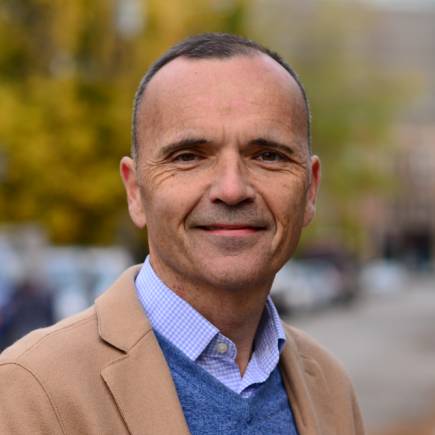We need to use more fully the tools we already have to steer development toward stronger, more inclusive communities.
Our country, our cities and our neighbourhoods are growing even faster than predictions made just a few years ago. One key highlight in Statistics Canada’s updated projections of population growth released in August 2022: Canada is on track to add as many as 14.3 million new residents by 2043.
Growth brings with it added pressures on transportation networks, housing, social services and governments at all levels in a variety of ways. The place where these pressures are arguably felt most acutely are the places we call home: our neighbourhoods. One persistent and concrete example of this is the effect that development and revitalization projects too often have of driving up rent and other living costs. This frequently leads to the displacement of long-time residents, small businesses and community-based organizations while also making it harder or even impossible for people on lower incomes to find a home in areas where it would have been easier in the past.
It doesn’t have to be this way. Development and gentrification are not synonymous. When equity principles are layered into planning, local growth and development can spur positive neighbourhood change that results in more inclusive communities – places that have robust social and physical infrastructure, where residents from diverse backgrounds and circumstances can enjoy meaningful participation in civic life, financial stability and affordable housing.
| Affordable, secure and adequate housing as an economic strategy
| Hitting the reset button on the national housing strategy
| A chance to get affordable housing right
While this kind of outcome can seem elusive, believe us when we say it is achievable. These very neighbourhoods are where United Way Greater Toronto focuses its research, builds constructive partnerships and pilots progressive models for employment, housing and local prosperity. On the ground in the Greater Golden Mile neighbourhood of Toronto, for example, our Inclusive Local Economic Opportunity initiative, in partnership with BMO, is channeling growth generated by major transit projects into direct economic opportunities for local residents. Our latest research report, Building Inclusive Communities: Learning from Programs and Policies that Work, identifies proven policy levers that can bring about more inclusive neighbourhood change in communities across Canada, and what it takes to implement them effectively.
Just as the elements that build inclusive communities are interconnected, these policy interventions work best when used together. Now that the affordability crisis has expanded from Canada’s major urban centres to communities across the country, we must deploy every tool we have to steer development toward communities, so people have the opportunity to build a better life.
Preserving affordability and preventing displacement
Our homes are the foundation from which we participate in community. When affordable and stable housing is out of reach, inequities are magnified. Being able to pay rent each month, remain in one’s home and community, or access housing that is affordable if one needs to move are keys to realizing housing as a human right. They are also a critical starting line for employment, financial security, civic and community engagement, and other forms of inclusion.
One of the most effective ways to preserve affordability and enhance tenure security is rent control, but the design of rent control policies matters. In North America, the term “rent control” has become synonymous with rent-increase caps, which can apply to both occupied and vacant units. In Canada, most provinces have adopted vacancy decontrol, capping rents for current tenants while allowing building owners to increase rents by any amount between tenants.
With housing affordability deteriorating across North America despite other rent control measures in place, vacancy control has gained traction as a critical part of preserving long-term affordability. Prince Edward Island is the only place in Canada with vacancy control established at the provincial level. Analysis of the impact of provincial rent control policies in Toronto, Vancouver and Winnipeg has found that vacancy control measures that are too limited can negate the immediate benefits of rent-increase caps that apply only to currently occupied units.
Rental unit replacement policies are a municipal requirement that rental housing be maintained or replaced one-for-one at similar rents in the event of renovation, conversion or demolition. Right-to- return policies offer residents the opportunity to come back to their neighbourhood or building after they are temporarily relocated due to redevelopment or renovation. These policies are intertwined and complementary because the right to return becomes ineffective without one-to-one unit replacement. But when combined with rent control – including strong vacancy control – right-to-return and rental unit replacement policies can help prevent displacement and preserve existing affordable rental supply into the long-term.
Inclusionary Zoning: Integrating affordability into new developments
Inclusionary Zoning (IZ) is a provincial planning tool that provides municipalities with the mandate to require or provide incentives to developers to designate a certain percentage of new housing development as affordable for low- and moderate-income households.
IZ regimes can differ widely, which can be a strength, allowing policymakers to customize an IZ policy to the needs of their local jurisdiction. But it can also limit their impact on affordability. In Ontario, for example, the More Homes Built Faster Act, 2022 has altered several aspects of municipal IZ policies that existed or were in development. Specifically, it lowers the proportion of affordable units required, increases price thresholds for what is considered affordable, and shortens timelines for housing to remain affordable. These new thresholds are substantially lower than those found in many other cities around the world.
Social procurement: Opportunities for systemically disadvantaged residents
What if every time we put a shovel in the ground for new infrastructure, we created new opportunities for those at risk of being left behind? That was the forward-looking idea behind a landmark community benefits framework designed by United Way, community partners and Metrolinx in 2014, aimed at ensuring that planned infrastructure projects strengthen local communities.
Social procurement is an extension of this idea. Local development projects offer opportunities to address historic underinvestment and economic barriers faced by marginalized communities. For example, municipalities may leverage local projects for opportunities and invest in businesses owned by members of historically marginalized groups by designing requests for proposals (RFPs) with criteria that promote workplace and supplier diversity. This approach is most successful when combined with supportive strategies such as workforce agreements, neighbourhood-level development programs and other ways to address potential barriers to employment.
In Toronto, we have seen social procurement policies benefit residents in neighbourhoods across the city. For example, local residents made up 72 per cent of hires for the Casino Woodbine development project in the Rexdale area in the northwest end of the city. This approach has been guided by the City of Toronto’s social procurement program.
More inclusive neighbourhood change is complex – and possible
We have seen these policy tools at work in cities across Canada and the U.S. We have also seen the difference they can make. When we plan with purpose and work collaboratively across sectors, with equity as a guiding principle, we can leverage growth to advance equity, deepen social and economic inclusion, and build vibrant neighbourhoods where everyone can thrive.

Isabel Cascante
Isabel Cascante is the United Way Greater Toronto’s Director of Research, Public Policy and Evaluation. Her work is rooted in evidence, partnerships and a commitment to more equitable research practices.

Daniele Zanotti
Daniele Zanotti is President and CEO of United Way Greater Toronto, the largest funder of social services in the Greater Toronto Area outside of government.
This article first appeared on Policy Options and is republished here under a Creative Commons license.